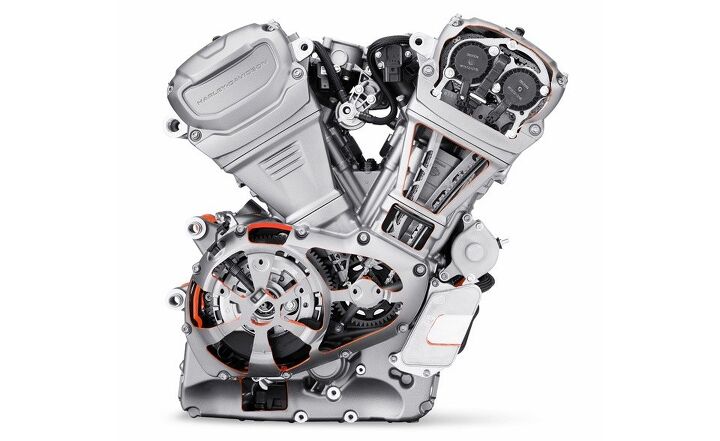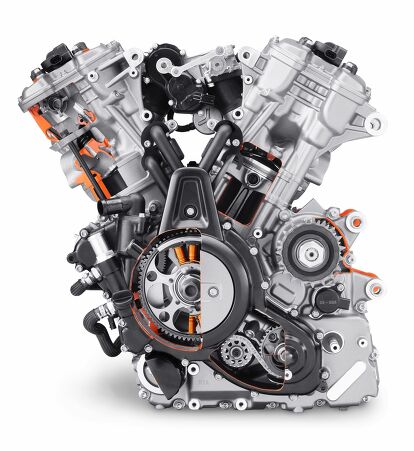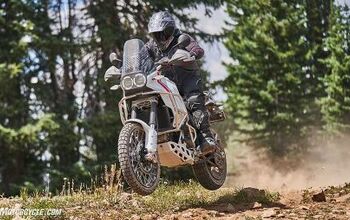More Than You Probably Wanted to Know About the Harley-Davidson 1250 Revolution Max Engine
All-new, All Milwaukee, and packed with tech you did not expect
We’ve already expended a ton of pixels talking about the new Harley-Davidson Pan America, most recently here. But Harley put out even more detailed pics and info in this release a few weeks ago about the all-new 1250 Revolution Max, or “Revmax” V-twin engine, that’s going to power it.
Eschewing the “not invented here” mentality it’s famous for, Harley included more sweet details in the new engine than you might’ve expected, including variable valve timing and scissors gear primary drive. Dual counterbalancers on a Harley? That’s correct, because: “Engine balancing contributes to weight reduction and motorcycle performance because engine components do not have to be designed to withstand stress inputs from vibration.” Though they couldn’t resist: “The balancers are tuned to retain just enough vibration to make the motorcycle feel `alive.’”
Hydraulic valve adjusters are a thing seldom found on motorcycles but almost always on cars, and we don’t understand why (peak rpm is 9500 here). And though you should never have to remove these cams to adjust valves since they’re hydraulic, you are able to lift the cams out without disassembling the camshaft drive if you need to – ala, the old TL1000 Suzuki and current V Strom 1050 engine. Somebody’s using their noggin.
Furthermore, H-D claims 150 horsepower and 94 ft-lbs torque (crankshaft) for its new engine, which is fully 30 hp and 7 ft-lbs more than Indian says its excellent liquid-cooled FTR1200 puts out. H-D’s not meaning to just provide comparable performance, but to blow its upstart competitor out of the water. Not that the Pan America and the FTR are quite in the same motorcycle category, but you know you’ll be seeing the Revmax in a bunch of new Harleys beyond the PA. We’ll have to wait for the dyno to tell the tale.
Finally, contrary to what you may have read, Harley’s Paul James would like to point out that this is an entirely new engine, with no parts shared with the Revolution (V-Rod) engine or Revolution X (Street) engine. It was also not a partnered or purchased engine, but rather entirely designed and developed in-house by HDMC and made in Milwaukee.
Harley-Davidson Press Release:
MILWAUKEE (February 22, 2021) – The Harley-Davidson Pan America 1250 and Pan America 1250 Special models are powered by the all-new Revolution Max 1250 engine, a liquid-cooled V-Twin designed to offer flexible, engaging performance with a broad powerband that builds to a rush of high-RPM power surging through the redline. The Revolution Max 1250 engine has been tuned specifically to deliver desirable power characteristics for the Pan America 1250 and Pan America 1250 Special models, with an emphasis on smooth low-end torque delivery and low-speed throttle control applicable to off-road riding.
“Through its history Harley-Davidson has embraced technological evolution while respecting the heritage of our brand, with engines that produce real-world performance for real-life riders,” said Harley-Davidson Chief Engineer Alex Bozmoski. “The Revolution Max 1250 is a clean-sheet, advanced-design effort that will carry Pan America riders over new horizons with reliability, efficiency, and exciting performance.”
A focus on performance and weight reduction drove both vehicle and engine architecture, material choices, and aggressive component design optimization. To minimize overall motorcycle weight the engine is integrated into the vehicle as the central member of the chassis. The use of lightweight materials helps achieve a desirable power-to-weight ratio. The Revolution Max 1250 engine is assembled at the Harley-Davidson Pilgrim Road Powertrain Operations facility in Wisconsin.
Revolution Max 1250 Engine
Displacement: 1250cc
Bore x Stroke: 4.13 in. (105 mm) x 2.83 in (72 mm)
Horsepower: 150 hp
Peak Torque: 94 ft. lbs.
Peak RPM: 9500
Compression Ratio: 13:1
Revolution Max 1250 Engine Technical Features
V-Twin Architecture
- A V-Twin design provides a narrow powertrain profile that centralizes mass to enhance balance and handling, and also provides ample foot/leg room for the rider.
- A 60-degree V angle of the cylinders keeps the engine compact while providing space between the cylinders for dual down-draft throttle bodies that maximize air flow and increase performance.
Reducing the weight of the powertrain contributes to lower motorcycle weight – reducing weight can enhance every aspect of motorcycle performance: efficiency, acceleration, handling and braking.
- The use of finite element analysis (FEA) and advanced design optimization techniques in the engine design stage minimized material mass in cast and molded components. For example, as the design progressed, material was removed from the starter gear and camshaft drive gears in an effort to lighten these components.
- Single-piece aluminum cylinders with nickel silicon carbide-surface galvanic coating are a lightweight design feature.
- Rocker covers, camshaft covers and primary cover are lightweight magnesium.
Stressed Member Powertrain
The Revolution Max 1250 powertrain is a structural component of the motorcycle chassis.
- The engine serves two functions – providing power and acting as a structural element of the chassis.
- Eliminating a traditional frame significantly reduces motorcycle weight and results in a very stiff chassis.
- A front frame element, mid frame element and the tail section bolt directly to the powertrain.
- The powertrain is designed to be both strong and very rigid so that it can effectively function as a chassis component.
- The rider realizes optimized performance due to a significant weight savings, a rigid chassis and mass centralization.
Liquid Cooling
Heat is an enemy of both durability and rider comfort. Liquid cooling the engine maintains a stable and controllable engine and oil temperature for consistent performance in changing environmental and riding situations.
- Powertrain performance is enhanced by tight component tolerances that can be achieved when engine temperature is controlled (there is less expansion and contraction of metal parts).
- Desirable engine sounds – a stirring exhaust tone – can predominate because noise from internal engine sources is reduced by liquid cooling.
- The engine oil is also liquid cooled, which ensures that engine oil performance and durability will be maintained in challenging conditions.
- The cooling system is designed to be esthetically pleasing, easy to service and rugged.
- The coolant pump is internal and features high-performance bearings and seals for extended service life.
- Coolant passages are integrated into a complex stator cover casting to save weight and reduce powertrain width.
- A coolant drain plug is recessed and guarded by a foot peg to limit vulnerability to damage in off-road riding situations.
Offset Connecting Rod Journals
The two crankshaft connecting rod journals are offset by 30 degrees. Harley-Davidson leveraged its extensive experience in flat track racing to help inform the cadence of Revolution Max 1250 engine power pulses.
- The 30-degree offset creates a 90-degree firing order that produces a smooth power delivery, especially at higher RPM.
- The cylinders are offset slightly to accommodate the crankshaft design, with the rear cylinder positioned to the rider’s left on the crankcase, a choice made to enhance ergonomics.
- The rider may gain control and confidence because the power pulses of a 90-degree firing order may improve traction in some off-road riding situations.
- The 90-degree firing order produces a stirring exhaust beat.
Forged Aluminum Pistons
- Piston crowns are machined for precise control of compression ratio. The 13:1 compression ratio improves engine torque at all speeds. This high compression ratio is made possible by advanced knock detection sensors. The engine will require premium-grade (91 octane) fuel to make maximum power, but will run on lower-octane fuel and is protected from detonation by the knock sensor technology.
- The base of the piston is chamfered so no piston ring compression tool is required for installation.
- The piston skirt has a low-friction coating.
- Low-tension piston rings reduce friction, which improves performance.
- The top ring land is anodized to enhance durability.
- Oil cooling jets are aimed at the bottom of the pistons to help dissipate combustion heat.
Four-Valve Cylinder Heads
- Four-valve cylinder heads (two intake and two exhaust) permit the largest-possible valve area.
- The rider realizes an optimal performance profile for adventure touring – strong bottom-end torque with a smooth transition to peak power – because the flow of gasses through the combustion chamber is optimized to match the desired performance requirement and engine displacement.
- The exhaust valves are sodium-filled to better dissipate heat.
- Suspended oil passages within the heads are made possible by a complex casting technique, and reduce weight because the head wall thickness is minimized.
- The cylinder heads are cast from high-strength 354 aluminum alloy. Because the heads act as a chassis mounting point, they are designed to be flexible at that mounting point but rigid over the combustion chamber. This is accomplished in part through targeted heat treating.
Double Overhead Camshafts (DOHC)
The Revolution Max 1250 engine is equipped with separate intake and exhaust camshafts for each cylinder.
- The DOHC design facilitates higher-RPM operation by reducing valve train inertia, which produces higher peak horsepower.
- The DOHC design permits independent Variable Valve Timing (VVT) on the intake and exhaust cam, optimized for the front and rear cylinder, to broaden the powerband.
- Specific cam profiles are selected to produce the most-desirable performance characteristics.
- The drive-side camshaft bearing journal is part of the drive sprocket, a design that makes it possible to remove the camshaft for service or a future performance upgrade without disassembling the camshaft drive.
- The camshaft drive chain guides and sprockets have been optimized to reduce as much mass as possible. The chain tensioner is internally mounted and incorporates design features to minimize start-up clatter.
Hydraulic Lash Adjusters
- The Revolution Max 1250 engine features roller-finger valve actuation with hydraulic lash adjusters.
- This design ensures that the valves and valve actuators (“fingers”) are in constant contact as engine heat changes.
- The hydraulic lash adjusters make the valve train maintenance-free, saving the owner time and cost – there is no mechanical adjuster.
- This design realizes a reduction in undesirable valve train noise, especially on cold starts.
- This design maintains consistent pressure on the valve stem, which facilitates more-aggressive camshaft profiles which can boost performance.
Variable Valve Timing (VVT)
The Revolution Max 1250 engine is equipped with computer-controlled Variable Valve Timing (VVT) on both the intake and exhaust camshafts.
- Through computer control, VVT advances or retards exhaust and intake camshaft timing independently through a potential range of 40 degrees of crankshaft rotation.
- VVT broadens the overall powerband and improves torque management and efficiency compared to the same engine with fixed valve timing. This allows the same engine to provide both low-end grunt for acceleration off the line as well as the thrill of high-RPM horsepower.
- VVT may improve fuel efficiency and increase range from each tank of fuel.
- The timing phaser is located between the cam drive sprocket and the camshaft, and uses a solenoid plunger to control ported hydraulics that change the cam timing.
- When the engine is shut down, VVT sets intake cams to full retard and exhaust cams to full advance to reduce compression for easier starting.
- Camshaft position pick-ups are located in the valve covers.
Dual Spark Plugs
The Revolution Max 1250 engine is equipped with two spark plugs per cylinder.
- Dual spark plugs improves ignition of the fuel charge across this wide-bore cylinder.
- The Revolution Max 1250 engine is equipped with “dual side strap” spark plugs that are designed to better manage high temperatures in the combustion chambers than a standard spark plug.
Dual Down-Draft Throttle Bodies
Separate throttle bodies are located between the cylinders, positioned to create minimal turbulence and impedance to air flow.
- High-velocity air flow into the combustion chamber is optimized for improved performance.
- Fuel delivery can be optimized individually for each cylinder, which can improve economy and range.
- The central location of the throttle bodies permits the ideal position of an 11-liter airbox over the engine. Airbox capacity is optimized for engine performance.
- The airbox is shaped to permit use of tuned velocity stacks over each throttle body that utilize inertia to pack more air mass into the combustion chamber, which can increase power output.
- The airbox is formed of glass-filled nylon with integrated internal ribs that help quell resonance and muffle intake noise. A forward-facing intake snorkel directs intake noise away from the rider. Silencing intake noise permits desirable exhaust tone to predominate.
- The circular base of the washable conical air filter provides an optimal seal to the airbox.
Robust Oiling System
The engine oiling system is scaled to perform well in challenging conditions.
- The engine features a dry sump oiling system, with the oil reservoir (or sump) incorporated into the crankcase casting below all rotating parts. This increases performance by reducing the parasitic power loss that can occur when a rotating part must pass through an oil bath.
- Triple oil scavenge pumps evacuate excess oil from three engine cavities – crankcase, stator cavity and clutch cavity. The rider gains optimal performance as parasitic power loss is reduced because internal engine components do not have to rotate through excess oil.
- A windage tray prevents the clutch from aerating engine oil, which could degrade oil delivery.
- The oil feed pump is fitted with a large-capacity screen able to filter debris for the lifespan of the motorcycle.
- The oil pump is designed to pull vacuum in the crankcase, which can further reduce internal engine friction because lighter piston ring pressure is required to minimize combustion blow-by.
- Oil delivery to main bearings and connecting rod bearings is delivered through the center of the crankshaft, a design that enables low oil pressure (60-70 psi) that reduces parasitic power loss at high RPM.
Fully Balanced Powertrain
Internal balancers cancel most engine vibration to enhance rider comfort and improve vehicle durability.
- Primary balancer: This spiral-shaped, chain-driven balancer located in the crankcase manages the primary vibration created by the crank pins, pistons and connecting rods, and also a “rolling couple,” or side-to-side imbalance, caused by the off-set cylinders.
- Secondary balancer: A small balancer located in the front cylinder head between the camshafts complements the primary balancer to further reduce vibration.
- The balancers are tuned to retain just enough vibration to make the motorcycle feel “alive.”
- Engine balancing contributes to weight reduction and motorcycle performance because engine components do not have to be designed to withstand stress inputs from vibration.
Clutch and Transmission
The Revolution Max is a unitized powertrain, meaning that the engine and six-speed transmission are housed in a common case.
- The clutch is mechanically actuated with a large-diameter cable for smooth, consistent disengagement and minimal drag.
- The clutch assist function offers a lighter feel at the clutch lever while maintaining the ability to transmit full torque and power to the transmission.
- The clutch features eight friction plates designed to provide consistent engagement at maximum torque throughout the life of the clutch.
- A clutch slipper function enables the rider to downshift without over-speeding the engine or slipping or hopping the rear wheel.
- To minimize NVH (noise vibration harshness) the primary gear assembly was designed to achieve the optimal balance of sound quality and performance. A custom-designed scissor gear reduces both backlash and gear meshing noise.
- Compensation springs in the primary gear smooth out torque pulses from the crankshaft before they reach the transmission, providing consistent torque delivery.
- The six-speed transmission shift system features roller bearings to support the shift drum and Teflon-coated shift shaft support bushings to minimize frictional losses and optimize shift quality.
- Internal shift components are durable but also as light as possible to improve shift quality and acceleration by minimizing power losses during shift events.
- The semi-dry transmission cavity reduces parasitic power loss and increases fuel economy for the customer because gears are not churning through oil.
More by John Burns









































Comments
Join the conversation
Love the cut-away views! Lots of tech stuff to look at and read about. Which I'll be doing in the near future. New era for HD, I hope they make the most of it. I thought the same thing about the Vrod engine, but, well, we know what happened with that. Great suspension, useable lean angles, just what I've been waiting for.
Love that they built this- That said one of the things I have enjoyed about my Harley Davidsons is I can roll them into my shop put it on a lift and tear it apart and customize it, build the engine with the improvements I want so when I am riding around I know I did a lot of the work and made the bike mine. Which is the same mentality a lot of hot rod builders have for their cars. I buy the bike and never have to set foot in a dealership again. I also have a BMW SS1000R I can't do that with that motor and TBH don't really want or need to it is a different experience and a different type of riding. I use mine mostly on the track. So I do hope HD keeps building motors we can work on instead of depending on a stealership.